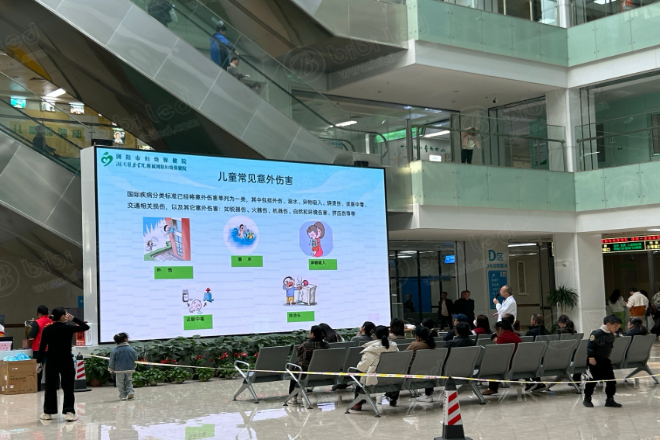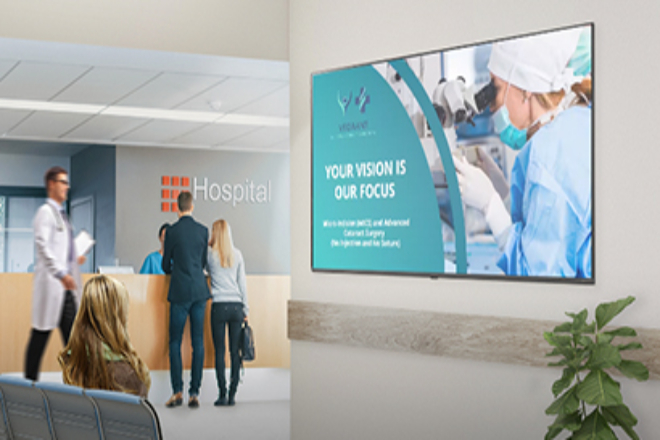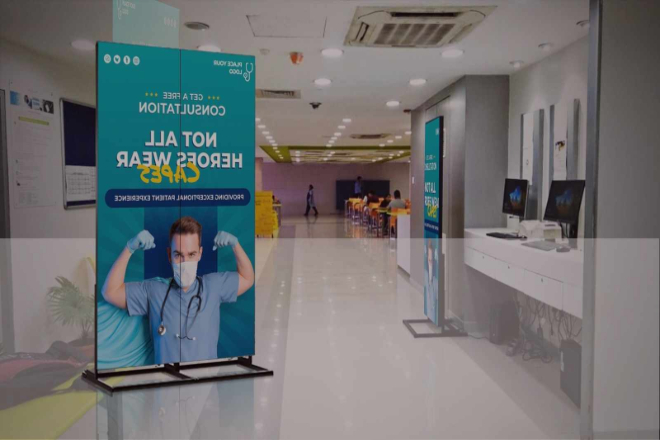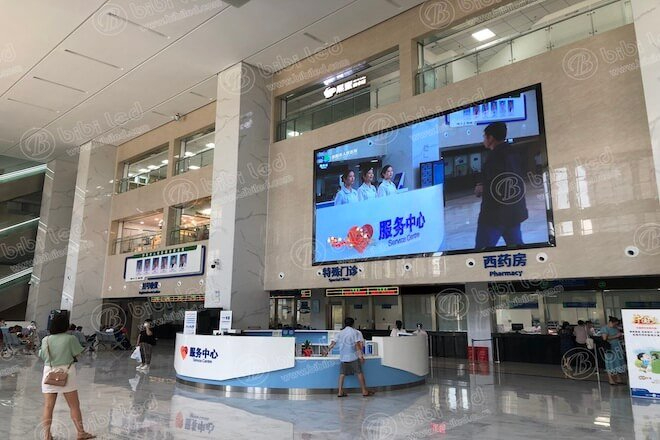Introducción
En hospital pasillos, pantallas de visualización LED Están cambiando silenciosamente todos los aspectos del entorno médico y la gestión hospitalaria.
No es solo una simple herramienta de visualización de información, sino también un excelente asistente. Entonces, ¿cómo desempeña un papel tan diverso en los hospitales?
Tabla de contenido
Uso 1: Se puede utilizar para visualización de información y orientación en hospitales.

1) Mejorar la imagen y la publicidad de los hospitales.
Colocar una pantalla LED en el vestíbulo del hospital puede sumar muchos puntos al hospital.
Por ejemplo, se pueden utilizar imágenes para mostrar la historia del desarrollo del hospital, los honores que ha ganado y el estilo de los médicos y enfermeras.
También está la cultura del hospital, para que los pacientes y sus familias puedan conocer más sobre el hospital y tengan más confianza en el hospital cuando están esperando.
También puede transmitir algunos consejos de salud, como cómo prevenir enfermedades comunes, enfermedades estacionales, etc., para ayudar a todos a aprender más sobre la salud.
Si desea que los pacientes sientan las intenciones del hospital, también es bueno mostrar el concepto de servicio del hospital, para que todos sientan que es confiable venir aquí para recibir tratamiento médico.
2) Mejorar la eficiencia de las operaciones hospitalarias.
Las pantallas LED también son muy útiles para las operaciones hospitalarias. Se pueden conectar al sistema de colas para mostrar el estado de las llamadas de cada departamento en tiempo real.
Los pacientes sabrán dónde se encuentran en la fila y no tendrán que apretujarse para entrar en la clínica. El orden de atención médica será mucho mejor.
También se puede utilizar en farmacias para mostrar información sobre medicamentos de uso común. Los pacientes pueden comprender claramente los medicamentos y los farmacéuticos pueden responder preguntas con mayor eficiencia.
Si se pueden mostrar las camas de hospital y los quirófanos, será más conveniente para el hospital administrar los recursos y se podrán organizar de manera razonable, y se mejorará la eficiencia general.
3) Mejorar la experiencia médica del paciente
Esta pantalla también puede hacer que los pacientes se sientan más cómodos cuando ven a un médico.
Por ejemplo, puede mostrar la temperatura, la humedad y la calidad del aire de la sala, para que todos sepan cómo es el entorno y se sientan más cómodos.
Si el pronóstico del tiempo se puede transmitir para recordar a todos que presten atención a los cambios climáticos.
O se puede reproducir alguna música relajante o clips de noticias, los pacientes no estarán tan ansiosos mientras esperan, su estado de ánimo será mejor y la experiencia médica mejorará naturalmente.
4) Promover la gestión y comunicación interna en el hospital.
Las pantallas LED también son muy útiles en el hospital. Permiten mostrar fotos, nombres y cargos de los empleados, lo que aumenta su sentido de pertenencia y facilita la localización de los pacientes.
Si hay avisos de reuniones internas e información de capacitación, una vez que se publican a través de la pantalla, el personal médico puede conocerlos a tiempo y la eficiencia de la comunicación será alta.
Los anuncios y avisos del hospital, como ajustes en los horarios de trabajo y descanso, reubicación de departamentos y uso de nuevos equipos, se pueden comunicar a todos a tiempo, lo que hace que la gestión del hospital sea más fluida.
Uso 2: Se puede utilizar para popularizar el conocimiento médico en el hospital.

La pantalla LED en el vestíbulo del hospital es una buena herramienta para ayudar a todos a aprender más sobre el conocimiento médico.
En primer lugar, puede proporcionar conocimientos sobre la prevención y el tratamiento de enfermedades comunes.
Por ejemplo, para resfriados comunes, presión arterial alta, diabetes, etc., la pantalla puede usar animación o video para explicar sus síntomas y cómo prevenirlos y tratarlos en detalle.
Por ejemplo, los pacientes con presión arterial alta pueden aprender a través de videos qué aspectos deben tener en cuenta en su dieta diaria, cómo tomar los medicamentos a tiempo y la importancia de controlar la presión arterial regularmente.
Este contenido es muy práctico para los pacientes, quienes pueden aprender muchos conocimientos mientras esperan.
Además de la prevención y el tratamiento de enfermedades, también es muy importante la promoción de un estilo de vida saludable.
La pantalla puede mostrar sugerencias para una alimentación saludable, como por ejemplo cómo combinar comidas nutricionalmente equilibradas y qué alimentos son especialmente buenos para el cuerpo.
También puede introducir sugerencias para hacer ejercicio razonablemente, como métodos de ejercicio adecuados para diferentes grupos de edad, cómo comprender la frecuencia y el tiempo del ejercicio; por supuesto, dejar de fumar y limitar el consumo de alcohol también son fundamentales.
A través de casos y datos vívidos, que todos comprendamos el impacto de estos hábitos en la salud.
De esta manera, los pacientes y sus familias pueden aprender cómo mantener un estilo de vida saludable y mejorar su conocimiento sobre la salud general mientras visitan a un médico.
Para los hospitales, las pantallas LED también pueden mostrar las tecnologías y servicios especiales del hospital.
Por ejemplo, las tecnologías médicas avanzadas del hospital, como la cirugía laparoscópica y el tratamiento mínimamente invasivo, suenan muy profesionales.
A través de una demostración animada del proceso quirúrgico, se explican claramente sus principios y ventajas.
Los pacientes podrán comprobar el poder de estas tecnologías y se sentirán más tranquilos. Por ejemplo, la cirugía mínimamente invasiva produce heridas pequeñas y una recuperación rápida.
Estas ventajas se muestran a través de animación y los pacientes pueden comprenderlas de forma más intuitiva.
Además, también se pueden promocionar bien los servicios especiales del hospital. Por ejemplo, es posible que muchos pacientes no conozcan la clínica de conveniencia.
Al presentar su proceso y ventajas a través de la pantalla, como el registro conveniente y el tratamiento médico rápido, se puede atraer a más pacientes a usarlo.
También existe un servicio de médicos de familia contratados. Mediante videos, podemos presentar los servicios que ofrecen los médicos de familia, como visitas regulares a domicilio y consultas de salud, lo que también puede aumentar el interés de los pacientes por probar estos servicios.
En resumen, las pantallas LED pueden desempeñar un papel importante en la popularización del conocimiento médico.
No sólo pueden ayudar a los pacientes a comprender la prevención de enfermedades y el conocimiento del tratamiento, sino también promover un estilo de vida saludable y mostrar la fortaleza y los servicios del hospital, matando dos pájaros de un tiro.
Uso 3: Puede mejorar la experiencia de los pacientes del hospital.

1) Creando un ambiente de espera
Al acudir al hospital para recibir tratamiento médico, los pacientes a menudo se sienten ansiosos e inquietos, y el tiempo de espera es aún más irritante.
Las pantallas LED pueden desempeñar un papel importante en el alivio de la tensión de los pacientes al reproducir contenido relajante.
Por ejemplo, se pueden mostrar vídeos de paisajes naturales, con lagos tranquilos, montañas continuas y bosques densos en la imagen, acompañados de música relajante, para que los pacientes parezcan estar en la naturaleza y se relajen gradualmente.
Además, puede reproducir sonidos naturales relajantes, como el canto de los pájaros, el sonido de los arroyos y las olas. Estos sonidos pueden aliviar eficazmente la ansiedad de los pacientes y crear un ambiente de espera cómodo y tranquilo.
Además del contenido relajante, la pantalla también puede proporcionar información de entretenimiento para que los pacientes no se aburran mientras esperan el tratamiento.
Por ejemplo, reproducir algunos programas adecuados para ver en el entorno hospitalario, como noticias, documentales y animaciones relajantes.
Las noticias pueden mantener a los pacientes informados sobre la actualidad, los documentales pueden proporcionar conocimiento y diversión, y las animaciones son adecuadas para los niños y pueden hacer que los padres se sientan más tranquilos.
A través de estos contenidos los pacientes pueden distraer su atención mientras esperan y reducir la ansiedad que provoca la espera.
2) Mejorar la comunicación médico-paciente
Una buena comunicación médico-paciente es fundamental para mejorar la experiencia del paciente. Las pantallas LED pueden desempeñar un papel fundamental en este sentido.
En primer lugar, los hospitales pueden introducir canales de retroalimentación de los pacientes a través de pantallas, como buzones de sugerencias, teléfonos de quejas y plataformas de retroalimentación en línea.
La visualización de estos canales puede permitir a los pacientes saber claramente cómo expresar sus opiniones y sugerencias y mejorar la confianza de los pacientes en el hospital.
Además, los hospitales también pueden utilizar pantallas para mostrar rápidamente el manejo de los problemas de retroalimentación de los pacientes.
Por ejemplo, cuando los pacientes se quejan de que el tiempo de espera en un determinado departamento es demasiado largo, el hospital puede publicar medidas de mejora y progreso en la pantalla.
Por ejemplo, «Hemos aumentado el número de guías y optimizado el proceso de registro. Gracias por sus comentarios».
Este tipo de visualización de información puede hacer que los pacientes sientan el cuidado y la atención que el hospital les brinda, mejorando así la confianza y la satisfacción de los pacientes con el hospital.
Gracias a estos métodos, las pantallas LED no solo pueden crear un entorno de espera cómodo, sino que también mejoran la comunicación entre médicos y pacientes, haciendo que la experiencia de los pacientes en el hospital sea más placentera y tranquilizadora.
Esto es de gran importancia para mejorar la calidad general del servicio del hospital y mejorar la experiencia médica de los pacientes.
Uso 4: Se puede utilizar para ayudar en la gestión hospitalaria y en la asistencia operativa.

En los hospitales, la asignación de recursos y la gestión de personal no son sencillas, pero las pantallas LED pueden ayudar mucho.
1) Visualización de la asignación de recursos
Hablemos primero de las salas. Nunca hay suficientes salas en el hospital, sobre todo en casos de urgencia. Es fundamental encontrar camas disponibles rápidamente.
Las pantallas LED pueden ser muy útiles. Permiten visualizar el uso de las salas en tiempo real, como qué sala tiene camas vacías, cuántas camas están disponibles y dónde se distribuyen las salas.
El personal médico puede ver esta información de un vistazo y puede organizar la hospitalización de los pacientes de manera rápida y precisa, sin tener que llamar, y los pacientes pueden esperar menos y sentirse tranquilos.
Analicemos el equipo médico. Los equipos grandes en hospitales, como las tomografías computarizadas y las resonancias magnéticas, requieren un uso frecuente, por lo que deben usarse de forma razonable.
La pantalla LED muestra el estado de las citas y el uso de estos dispositivos. Por ejemplo, ¿está completa la cita de TAC de hoy a las 15:00 y el equipo funciona con normalidad?
De esta manera, el personal médico puede organizar el tiempo del examen del paciente con anticipación para evitar que los pacientes hagan un viaje en vano, y el equipo también puede funcionar de manera más eficiente y no estará inactivo por mucho tiempo.
2) Gestión del personal
En el hospital, la disciplina laboral del personal médico también es fundamental. Algunos requisitos de disciplina laboral pueden visualizarse en la pantalla LED cerca del área de trabajo del personal médico.
Por ejemplo, recordatorios como “Por favor, entregue a tiempo” y “Por favor, siga estrictamente el proceso de desinfección”.
De esta manera, el personal médico puede ver estos requisitos cada día y trabajar de forma más estandarizada.
Además, el hospital también puede desempeñar el papel de una pantalla de monitoreo en el área de trabajo a través de la pantalla, pero debe prestar atención a proteger la privacidad de los pacientes y no exponer la información del paciente.
Estas imágenes pueden ayudar a la administración del hospital a comprender si el personal médico está trabajando de acuerdo con los procedimientos operativos estándar.
Por ejemplo, si la desinfección se realiza a tiempo, si se utiliza el equipo de protección necesario, etc.
Si los problemas se detectan y corrigen a tiempo, no solo se puede mejorar la eficiencia del trabajo, sino también garantizar la seguridad de los pacientes y llevar la calidad del servicio del hospital a un nivel superior.
En resumen, las pantallas LED pueden ayudar mucho en la gestión del hospital, haciendo que la asignación de recursos sea más eficiente y la gestión del personal más estandarizada, y el funcionamiento del hospital naturalmente será más fluido.
5. Conclusión
A través de la introducción anterior, podemos ver que la aplicación de pantallas LED en salas de hospitales es mucho más que eso.
No solo proporciona a los pacientes una experiencia médica más cómoda y conveniente, sino que también aporta mayor eficiencia y transparencia al funcionamiento y la gestión del hospital.
En el futuro, con el avance continuo de la tecnología, la aplicación de pantallas LED en el campo médico será más extensa y profunda.
Finalmente, si quieres saber más sobre las pantallas LED, Por favor póngase en contacto con nosotros.
